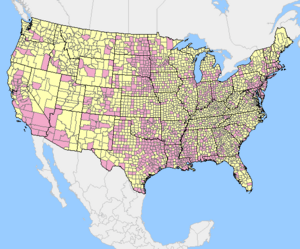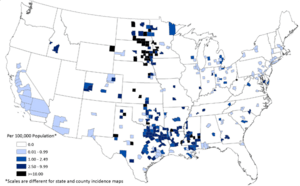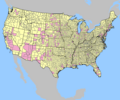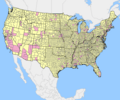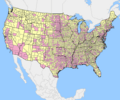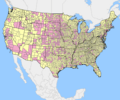West Nile virus in the United States facts for kids
The West Nile virus first appeared in the United States in Queens, New York in 1999. It quickly spread across the country. Scientists believe the virus arrived in an infected bird or mosquito. The disease spreads among birds first. Then, mosquitoes bite infected birds and can spread the virus to people and other animals. Horses are often affected, but many other animals can get it too.
Usually, human cases appear within three months after infected birds are found. This happens unless cold weather stops the mosquitoes. Since the virus became common in the U.S., about 130 deaths happen each year. It's hard to compare the number of cases directly. This is because different health departments report cases in different ways. Also, more people look for the disease as it spreads.
For example, in 2009, 720 cases were reported. But experts think the real number of infected people was around 54,000. Most cases are very mild, so people don't even know they have it. This means the actual death rate is much lower than it seems. Only about 1% of all cases are severe. Older people or those with weak immune systems are most likely to get seriously sick or die. This can happen if they are bitten by a mosquito carrying West Nile virus.
Between 2003 and 2005, over 1,000 blood donations were found to have West Nile virus. Before blood screening started in 2002, about 30 cases of West Nile were spread through blood transfusions. In the first ten years, over 1,100 deaths happened in the U.S. Every state except Maine, Alaska, and Hawaii reported human cases. In 2012, there was a large outbreak. It had the most deaths and the second-highest number of total cases. Maine and Puerto Rico reported their first cases that year.
Contents
How West Nile Virus Was Found in the U.S.
In August 1999, Dr. Deborah Asnis worked at Flushing Hospital Medical Center in Queens. She noticed two male patients with strange symptoms. The men, aged 60 and 75, suddenly had weak arms and legs. They were also confused and had high fevers. Lab tests showed they had too many white blood cells in their spinal fluid. Antiviral medicines were not helping them.
Doctors first thought it might be botulism, viral encephalitis, Guillain–Barré syndrome, or meningitis. But none of these diseases perfectly matched the symptoms. Dr. Asnis decided to get a clearer answer. She contacted health authorities and other doctors.
On August 23, 1999, Dr. Asnis called Dr. Marcelle Layton. Dr. Layton was the chief epidemiologist for the New York City Department of Health. Dr. Layton told Dr. Asnis to send blood and spinal fluid samples. These samples went to the New York State Department of Health in Albany for more tests.
Just four days later, on August 27, two more patients in Queens had similar symptoms. By August 29, the number grew to eight patients. All of these early patients lived close to each other. They also often gardened in the evenings.
The Centers for Disease Control and Prevention (C.D.C.) first said the mystery illness was St. Louis encephalitis. This was on September 3, 1999. New York City then started spraying for mosquitoes that same day. However, lab tests continued to find the exact cause of the symptoms.
On September 27, 1999, the U.S. government changed its diagnosis. They said it was West Nile virus instead of St. Louis encephalitis. This change was based on research by Dr. Duane J. Gubler, a C.D.C. expert. It was also based on several bird deaths in the Bronx, just north of Queens.
Health experts gave Dr. Deborah Asnis credit for finding West Nile virus early in the United States. Her actions likely stopped the outbreak from spreading even more. In their 2003 book, The New Killer Diseases, authors Elinor Levy and Mark Fischetti praised Dr. Asnis. They wrote that "Asnis did something other doctors might not have bothered to do." They explained that many doctors don't report strange symptoms. This can be because they are unsure, don't know the rules, or just don't get around to it. They said Dr. Deborah Asnis was very careful and responsible.
Recent Cases of West Nile Virus
Between 1999 and 2010, about 3 million people in the United States were infected. The highest rates of infection are in states like South Dakota, Wyoming, and North Dakota. These states are in the central Great Plains.
In 2012, there was a large West Nile virus outbreak in Texas. During this time, 1,868 cases were reported. Men, people over 65, and minorities had the highest risk of serious brain infections. Out of these cases, 844 (45%) were severe brain infections. There were also 89 deaths, meaning 5% of reported cases led to death.
The outbreak in Texas lasted from May 1 to December 6, 2012. It was at its worst in mid-August, with 225 reported cases. This peak time was similar to past West Nile outbreaks in Texas. It took about 27 days for a case to be officially reported after symptoms started. Out of Texas's 254 counties, 135 (53%) reported a West Nile case. The overall rate for the state was 7.8 cases per 100,000 people. Almost half of the cases were in the Dallas/Fort Worth area. This included Dallas, Tarrant, Collin, and Denton counties. These four counties had a combined rate of 16 cases per 100,000 people.
West Nile Virus Cases and Deaths in the U.S.
| Year | Cases | Deaths | Death Rate of Reported Cases |
|---|---|---|---|
| 1999 | 62 | 7 | 11% |
| 2000 | 21 | 2 | 10% |
| 2001 | 66 | 10 | 15% |
| 2002 | 4,156 | 284 | 7% |
| 2003 | 9,862 | 264 | 3% |
| 2004 | 2,539 | 100 | 4% |
| 2005 | 3,000 | 119 | 4% |
| 2006 | 4,269 | 177 | 4% |
| 2007 | 3,623 | 124 | 3% |
| 2008 | 1,356 | 44 | 3% |
| 2009 | 720 | 32 | 4% |
| 2010 | 1,021 | 57 | 6% |
| 2011 | 712 | 43 | 6% |
| 2012 | 5,674 | 286 | 5% |
| 2013 | 2,469 | 119 | 5% |
| 2014 | 2,205 | 97 | 4% |
| 2015 | 2,175 | 146 | 7% |
| 2016 | 2,149 | 106 | 5% |
| 2017 | 2,097 | 146 | 7% |
| 2018 | 2,647 | 167 | 6% |
| 2019 | 958 | 54 | 6% |
| 2020* | 540 | 33 | 6% |
Sources: Final Cumulative Maps & Data for 1999–2018, Preliminary Maps & Data for 2019, and West Nile Virus Disease Cases by State 2020, Centers for Disease Control and Prevention
- In 2019, 104 possible cases were found in blood donors.
-
- As of December 15, 2020, 127 possible cases were found in blood donors.
Maps Showing How West Nile Virus Spread
These maps show how human cases of West Nile virus spread across the United States. The colors show what percentage of all U.S. West Nile cases a state had that year.
- White means 0% (no cases).
- Blue means less than 1%.
- Green means between 1% and 5%.
- Yellow means between 5% and 10%.
- Red means more than 10% of cases in that year.
Maps of Reported Cases by County Each Year


